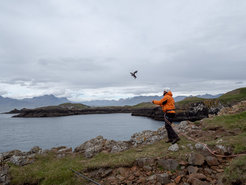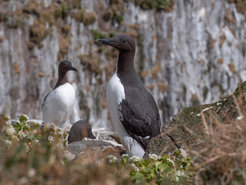LOMVIA - Linking Oceanography and Multi-specific, spatially-Variable Interactions of seabirds and their prey in the Arctic
Climate change is having obvious and severe impacts in the polar regions. The Arctic is currently warming at more than double the rate of other parts of the globe, causing unprecedented change to the region’s ocean environment. The Arctic Ocean’s ecosystem is especially sensitive to warming because of its reliance on sea ice as the living space for multiple organisms from ice algae to polar bears. Besides the physical impacts such as warming oceans and melting sea ice, the changing environment also affect how different species interact with one another. In particular, rising temperatures mean that the range of temperate species can expand northward and bring them into increasing contact with Arctic species. As a consequence, Arctic species may be outcompeted for food or breeding sites, causing more rapid declines than would occur if climate change acted alone.

While many of us are familiar with the blatant impacts of climate change on large, migratory species such as polar bears and whales in the Arctic, we are often less familiar with the changes wrought on the ecological webs of smaller, though no less important, marine animals in these changing environments. Project LOMVIA seeks to close this knowledge gap by investigating the impacts of climate change on competition between a pair of closely related seabird species in Iceland, the Brünnich’s guillemot (Uria lomvia) and the common guillemot (Uria aalge). The Brünnich’s guillemot is increasingly in closer contact with common guillemot as the latter species is expanding northwards as a consequence of climatic warming. LOMVIA focuses on the coast of Iceland, which acts as a ‘miniature Arctic’ at the centre of a series of complex current flows that include icy Arctic water from Greenland, warm temperature water from the Atlantic, and subarctic water from Norway.

The LOMVIA project provides new resolution in the study of the diets and ecological adaptations of these competing species. LOMVIA employs a suite of complementary methods to investigate the competition between the two species and their geographical foraging patterns. Notably, Department of Archaeology contributes by applying biomolecular methods pioneered at the Department of Archaeology for ancient samples to modern blood and feather samples. These data will alongside colony counts made by Icelandic partners and tracking data obtained by British partners, provide insights into how human actions and a warming climate may interfere with guillemot foraging. This interdisciplinary collaboration will potentially represent a major advance in the study of contemporary Arctic ecosystems, and consequently have implications for modern day policy and conservation issues.



